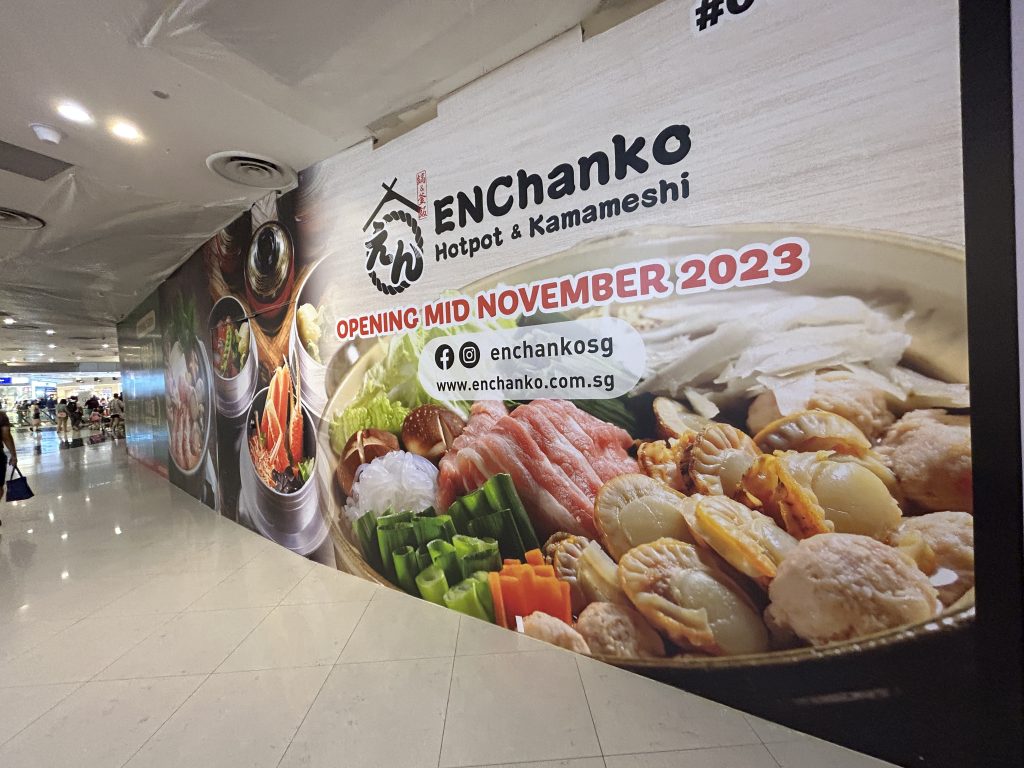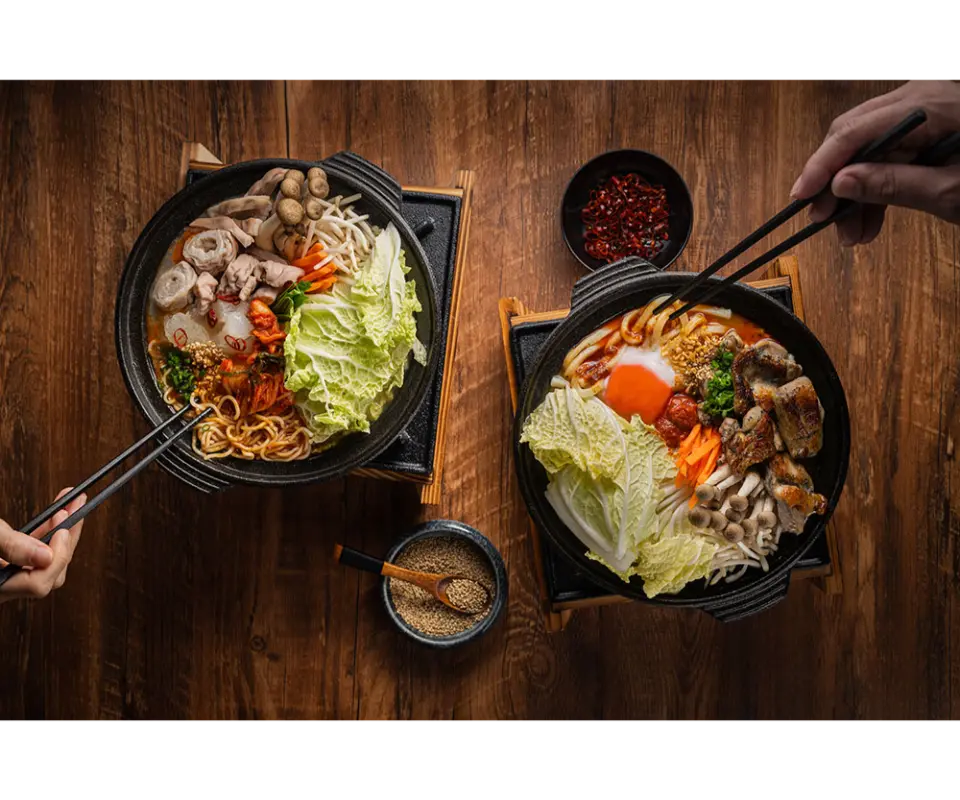
Brian Kennett
Amateur Chef and Boozy Traveling Foodie Extraordinaire
Enchanko Hotpot Reviews: If you’re after an authentic Japanese hotpot experience with a unique twist, ENchanko Hotpot & Kamameshi at VivoCity is an exciting option to consider. Known as Singapore’s first dedicated chanko hotpot restaurant, ENchanko offers a traditional Japanese sumo-style hotpot, or Chankonabe.
This hotpot, which originated in sumo stables, is hearty, nutritious, and packed with ingredients like Jitori chicken, seasonal vegetables, and a variety of broths. Their signature dish, Tori Chankonabe, is a customer favourite, combining rich flavours with comfort. You’ll also find quirky additions like the Himokawa Udon—a flat and wide udon noodle exclusive to ENchanko, giving diners a distinctive texture and a new take on traditional udon
Beyond the hotpot, ENchanko serves Kamameshi, a Japanese rice dish cooked in an iron pot and topped with choices such as Miyazaki Wagyu or salmon. The experience is heightened with the option to add collagen for an extra layer of indulgence in the soup. Situated conveniently in VivoCity, the restaurant’s sumo-themed decor and easy access from the MRT make it a memorable stop for groups and families. It’s an all-encompassing Japanese dining experience without the hassle of finding authentic options elsewhere.
Enchanko HotPot Near Me
Of course, this depends on where you are when you ask the question: “Enchanko Hotpot Near Me…” But Enchanko Hotpot now has two locations…
- 1 HarbourFront Walk, #01-52 VivoCity
- 3 Temasek Blvd, B1-122A Suntec City
EnChanko HotPot Self Review
“ENChanko started off as ENChanko Hotpot & Kamameshi, Singapore’s only chankonabe specialty restaurant at the end of November 2023. Inspired by sumo wrestlers’ diets, these hearty hotpots come with chockful of protein and an assortment of vegetables, creating a very well-balanced diet. The hotpot comes in sharing portions of 2 or 4 people and customers can opt to add on more dishes. ENChanko is also one of the first Japanese restaurants in Singapore to launch the viral Himokawa Udon.
Savour our Signature Tori Chankonabe with all things chicken, or the Buta Motsunabe – an offal hotpot delicacy that features high protein and collagen content, despote being low in calories.”
ENChanko Hotpot and Kamameshi Vivocity Review (before opening)
I can’t see any reference to this restaurant on the interweb so have to assume this is a new brand for Singapore and Vivocity. We’ll try and keep an eye on the opening for you and get some of this grub in our tummies and write it up for you.
Points of reference to what you’re about to be able to eat, from the close of November 2023 are:
Chanko Hotpot: A Sumo-Size Culinary Tradition
Chanko Nabe, also known as Sumo Stew, is a hearty hot pot originating from Japan, particularly popular among sumo wrestlers. This robust dish features a rich broth, often made with dashi and chicken, and is filled with a variety of vegetables, proteins like chicken and tofu, and other ingredients. It’s considered a reasonably healthy meal, despite being calorie-rich, and it’s traditionally served in substantial quantities.
The term “chanko” refers to all types of cuisine prepared by sumo wrestlers. The word “chanko” is derived from “chan,” meaning “parent,” and “ko,” meaning “child,” signifying the act of everyone, including coaches and trainees, eating together. Chanko Nabe is not limited to sumo culture; it’s enjoyed in Japanese homes and restaurants.
Kamameshi: likely a traditional Japanese rice dish cooked in an iron pot called a “kama.” The name “kamameshi” literally translates to “kettle rice.” It is similar to takikomi gohan, but the distinguishing feature is the use of an iron pot for preparation. Kamameshi typically consists of rice, along with a variety of ingredients such as mushrooms, chestnuts, konjac, carrots, lotus root, and shredded eggs. The rice and ingredients are cooked together in the pot, creating a flavorful and aromatic dish. The history of kamameshi dates back to the 1920s and is said to have originated after the Great Kanto Earthquake, as people would gather to eat rice communally during a time of hardship.

Savouring Tradition: ENChanko Hotpot and Kamameshi Delights Review
Japanese cuisine is a treasure trove of flavours and culinary traditions, and two dishes that exemplify this rich heritage are Enchanko Hotpot and Kamameshi. In this food blog, we’ll introduce a new location at Vivocity which is about to be serving to serve this delightful Japanese dish.
This Hotpot, a close relative of Chanko Nabe, is a hearty Japanese dish rooted in sumo wrestling culture. It’s a robust hot pot filled with various ingredients like chicken, vegetables, tofu, and seafood, all simmered in a rich dashi and chicken broth. This dish not only caters to the sumo wrestlers’ enormous appetites but also offers a nutritious and flavorful meal for everyone. Its communal aspect makes it perfect for sharing with family and friends, and it’s a true celebration of Japanese comfort food.
Kamameshi, on the other hand, is a flavorful rice dish cooked in an iron pot, known as a kama. This traditional Japanese dish combines rice with an assortment of ingredients like seafood, vegetables, and mushrooms, infused with a savoury soy-based sauce. The rice is cooked to perfection and served right in the kama, allowing diners to savour the crispy layer at the bottom, known as “okoge,” a prized treat for many. Kamameshi offers a unique dining experience where the ingredients and flavours meld together to create a memorable meal.
Both Enchanko Hotpot and Kamameshi require meticulous preparation and attention to detail. The choice of fresh ingredients and the art of seasoning are key to their success. The communal aspect of the Hotpot and the distinct presentation of Kamameshi in a traditional iron pot add to the overall experience, making them not just a meal but a journey into Japanese culture.
Enchanko Hotpot and Kamameshi are two delicious windows into the world of Japanese cuisine. Whether you’re a fan of the hearty and communal experience of the Hotpot or the aromatic and savoury delights of Kamameshi, both dishes offer something unique worth trying.
So, the next time you’re looking for an authentic taste of Japan, consider savouring these traditional dishes that have stood the test of time, offering a taste of history and a delicious experience in every bite.
ENChanko Hotpot Menu Overview
| Dish | Description | Price |
|---|---|---|
| Signature Tori Chankonabe | Jitori chicken, tsukune, glass noodles, vegetables (4 or 2 pax) | $58 (4 pax), $30 (2 pax) |
| Buta Motsu Chankonabe | Pork stomach, intestines, tendon, vegetables, sesame, garlic (4 or 2 pax) | $65 (4 pax), $35 (2 pax) |
| Kaisen Chankonabe | Seafood with prawns, scallops, clams, mushrooms, noodles (4 or 2 pax) | $75 (4 pax), $39 (2 pax) |
| Individual Hotpots | Options: Tiger prawn, Miyazaki Wagyu, chicken, pork, vegetables | Starting at $14.8 |
| Kamameshi Sets | Rice pot dishes with assorted seafood, wagyu, chicken, or vegetables | Starting at $14 |
| Add-Ons | Additional vegetables, meat, seafood, noodles, and rice options | Varied, $1.8+ |
| Sides | Assorted sides like edamame, tofu, fishcake, fries, karaage, octopus in wasabi | Starting at $4.5 |
| Desserts | Matcha, chestnut, goma ice creams, yuzu sherbet | Starting at $3.8 |
| Beverages | Sake, plum wine, highball cocktails, cold brews, fruit juices, teas | Varied, $2+ |
People also asked about ENChanko Hotpot...
| Question | Answer |
|---|---|
| How do you make Enchanko Hotpot? | To make it, simmer chicken, vegetables, and tofu in a rich dashi and chicken broth. Add various ingredients as desired. |
| What are the key ingredients in Enchanko Hotpot? | Key ingredients include chicken, tofu, mushrooms, vegetables, and seafood, all cooked in a flavorful broth. |
| Is Enchanko Hotpot similar to Chanko Nabe? | Yes, it is similar to Chanko Nabe, both being hearty hotpot dishes popular in sumo culture. |
| Can Enchanko Hotpot be customized? | Absolutely! You can customise it by adding your favourite ingredients to suit your taste. |
| What is the history of Enchanko Hotpot? | It has its roots in sumo wrestling culture and has been enjoyed for generations as a nutritious and flavourful dish. |
| Are there vegetarian options for Enchanko Hotpot? | Yes, you can create vegetarian versions by using tofu and a variety of vegetables. |
| How is Enchanko Hotpot served in Japanese restaurants? | In restaurants, Enchanko is often served in a communal pot, allowing diners to share the meal. |
| Can you recommend any Enchanko Hotpot variations? | Popular variations include seafood and spicy with added chili paste. |
| What are some side dishes that pair well with Enchanko Hotpot? | Side dishes like rice, pickles, and a cold beer complement the flavours. |
| Where can I find authentic Enchanko Hotpot outside of Japan? | You can explore Japanese restaurants and hotpot eateries worldwide to enjoy authentic Enchanko Hotpot in Viviocity |
Contact Details for EnChanko Hotpot
Telephone: 6255 9188
1 Harbourfront Walk, #01-52 Vivocity


